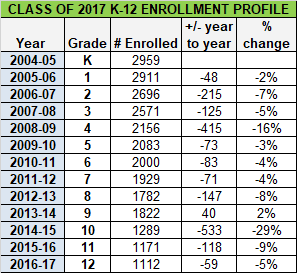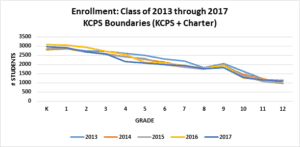With student enrollment declining by more than 40% between 9th and 12th grades, public high school in Kansas City feels more like a leaky pipe than a saturated marketplace. Are we asking the right questions?
One of the biggest questions in our ongoing high school conversation is: don’t we already have too many?
During the 2016-2017 school year there were 14 public schools serving about 5,800 students. The biggest, East, served ~1000 students. The smallest, Allen Village, served less than 200. Several schools had empty seats.
Right now in Kansas City there are at least three new high school initiatives underway.
Does Kansas City really need more high school options? Shouldn’t we just try to fill the seats we have?
_____________________
Since we live in a choice system, I thought it would be interesting to look at the enrollment choices families and students are making as they move through our public school system.
Let’s start by looking at the Class of 2017.
The Class of 2017
It’s Fall 2004. About three thousand students show up for their first day of Kindergarten in both KCPS and charter schools.
As these students move through the system year-to-year, class enrollment begins to shrink: by the time they reach sixth grade, the Class of 2017 is down to 2,000 students.

Enrollment declines until ninth grade, when this cohort gains students (research shows that more students repeat 9th grade than any other, resulting in a “ninth-grade bump”).
This bump, however, is followed by an enrollment cliff – a 30% drop – where the Class of 2017 loses more than 500 students between 9th and 10th grade. This enrollment drop represents the largest single loss of students – both in absolute numbers and by percentage – in this cohort’s K-12 experience. And it happens during high school.
By senior year, Fall 2016, the Class of 2017 is just 1100 students, one-third of its original size. And this is months before graduation.

Overall, Class of 2017 enrollment shrinks by almost 40% between grades 9 and 12 – a loss of 710 students over four years.
And between Kindergarten and 12th grade, enrollment shrinks by 1,847 students – more than 60%.
What about other graduating classes?
This enrollment profile is illuminating, but represents the experience of just one cohort of students as they move through the system.
What does the data look like, on average, for the last five graduating classes, going back to 2013? And how do these enrollment stories differ between KCPS and charter schools?
Here’s a graph that summarizes year-to-year enrollment for the last five graduating classes within KCPS boundaries, from Kindergarten through 12th grade.

The story is remarkably consistent: for the classes of 2013 through 2017 there’s a steady decrease in enrollment from fall of Kindergarten year through fall of 8th grade.
After a bump in 9th grade, enrollment declines again – by 47%, on average, between 9th and 12th grade. (Click here to see year-to-year data for all five classes).
Here’s another look at the same data, broken out by school sector (KCPS and charter).

As these five cohorts move through the system, the charter sector, on average, gains students every year until grade 7. Starting in 8th grade, charter enrollment begins to decline.
KCPS, on average, loses enrollment every year except for grade 9.
High school is the only place on our K-12 continuum that both KCPS and charter schools lose student enrollment overall. Key take-away: High school isn’t just a KCPS or a charter problem.
Why does this matter?
Context is important for any conversation. Over the past several years the number of students choosing public high school within KCPS boundaries has decreased. Of those enrolled, nearly 5 of 10 students exit the system, on average, between the fall of their 9th and 12th grades. And the number of students who actually make it through to graduation is even lower.
Where are these students going? Enrollment numbers alone can’t tell us. Some are leaving the district altogether. Others are going to private schools. Far too many are dropping out entirely.
It’s against this backdrop that the overall high school debate in Kansas City is taking place.
Based on these data I’m not sure that “Do we have too many high schools?” is the right question to be asking. Looking closely at the numbers, high school in Kansas City feels more like a leaky pipe than a saturated marketplace.
A better question might be: does Kansas City have enough quality public high school options, high schools that families want to send their kids to -and where kids want to be – that are doing great things for students of all socio-economic backgrounds?
The scope of this problem requires more than a one school solution. How can we work together to fix it?
Have your charts been adjusted for the 2008 KCPS school boundary change where Van Horn High School and its feeder schools were transferred to Independence?
If not, it would not be accurate to compare the 2004 Kindergarten class to the 2016 12th grade class because those two time frames do not cover the same geographic areas.
Thanks for your question, Anonymous.
As background for other readers: in 2008, seven KCPS schools* (5 elementary schools, one middle school and one high school) were transferred, or annexed, to the Independence, MO School District. This annexation resulted in a one-time loss of about 2900 K-12 students for KCPS during the 2008-2009 school year. Obviously this was a big hit to KCPS, and for public school enrollment within our district in general.
I did take the annexation into account when conducting my high school analysis — but found that it didn’t change the overall enrollment story that much because the biggest drops in enrollment for all of these classes, by far, is happening *during* high school. I will explain.
The largest drop in enrollment for the Class of 2017 – both in absolute numbers and by percentage – occurs eight years after the Independence Annexation, when the class of 2017 loses more than 500 students between 9th and 10th grades (see chart).
The year before the Independence annexation, the Class of 2017 was in 3rd grade. There were 234 third graders enrolled in these seven schools – 9% (234/2571) of all third-graders in our district that year. The following year, because of annexation, 4th grade enrollment in these schools goes to zero.
So annexation absolutely increases attrition for the Class of 2017 between 3rd and 4th grades, accounting for more than half of the 415 students, both KCPS and charter, that leave our district that year. But this loss of 234 students in 2008 has little bearing on what happens when the Class of 2017 reaches high school in Fall 2013 — and enrollment drops by +500 students before 10th grade.
I also looked at the Classes of 2013 through 2016, with the same results. The class of 2013, which would have been the oldest class during annexation, was in 7th grade the year before annexation, the Class of 2014 was in 6th grade, the Class of 2015 was in 5th grade, and the Class of 2016 was in 4th grade. Even when you include the losses resulting from annexation, all of these classes still experienced their largest loss in enrollment *after* they got to high school. Which leads me to believe that we have a high school problem – and that we need to start doing something differently.
Thanks again for your question, I hope this explanation is helpful. If you have a different perspective, please feel free to share it.
*KCPS schools annexed to Independence were: Van Horn High School; Nowlin Middle School; and Fairmount, Mt. Washington, North Rock Creek/Korte, Sugar Creek, and Three Trails Elementary Schools.